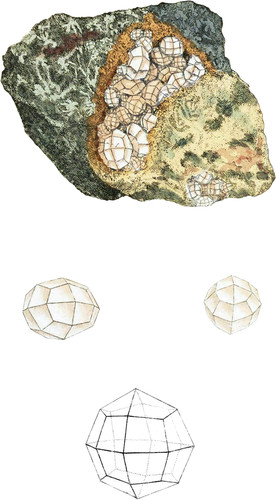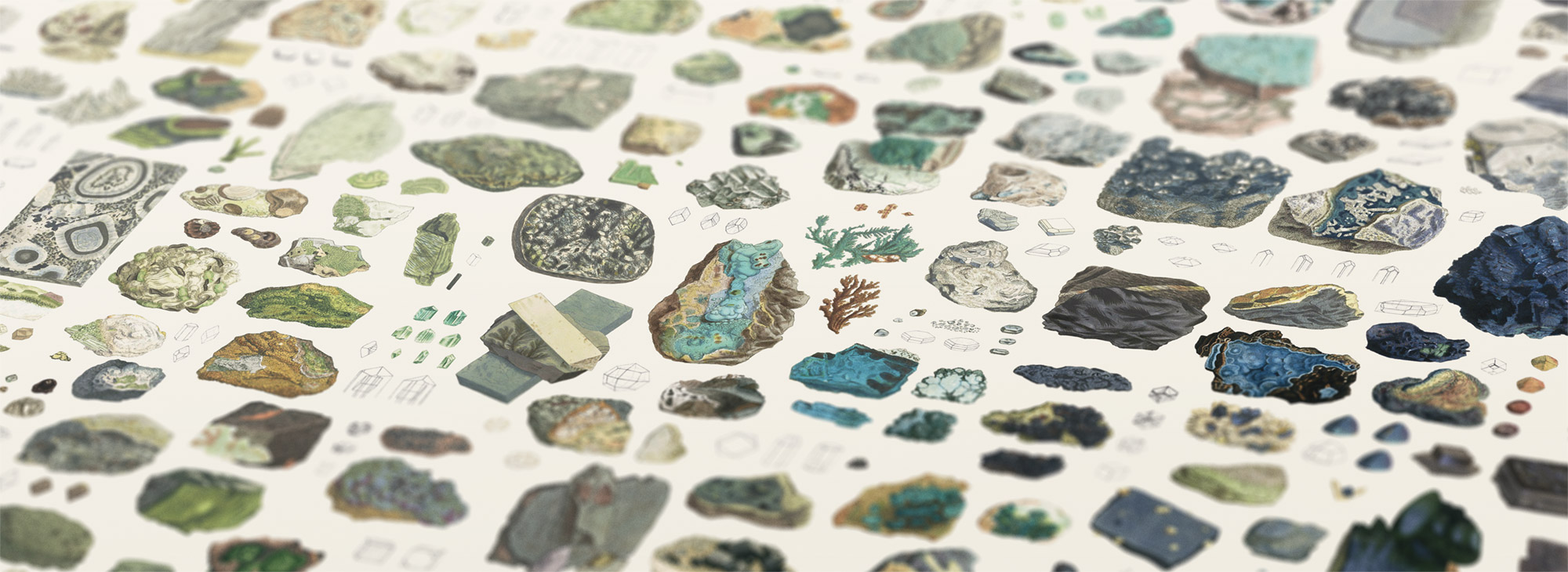 Enlarge
Enlarge
British Mineralogy
Analcime
- Class 2. Earths.
- Order 1. Homogeneous.
- Gen. 4. Silex.
- Spec. 16. Analcime.
- Spec. Char. Primitive form, the cube. Spec. grav. about 2. Electricity difficult to excite by friction. Vitreous. Fusible per se into a transparent glass.
- Syn.
- Vesuvian or white Garnet. Kirw. v. 1. 285.
- Wurfel zeolith. Emmerl. v. 1. 205.
- La zeolithe cubique. Broch. v. 1. 304.
- Analcime. Haüy, v. 3. 180.
Vesuvian or white Garnet* is the only substance mentioned in Kirwan that at all agrees with this species†: but in this, as in many other substances described by that great author, he does not observe whether he had ever seen any thin like it found in Great Britain.
The specimen here figured came from Kirkleston, 8 miles west of Edginburgh, and seems always to present the same crystallization more or less compressed. The crystals vary in transparency from translucid to nearly opaque white, and are often of a pale red, sometimes of a dull salmon colour. I was favoured with some of these from Calton Hill near Edinburgh by Mr. Neale. The fracture is often very confused, and somewhat like quartz after being dropt red hot into water. I however had the good luck to find one, among many specimens sent me by Mr. J. Murray of Edinburgh, with the proper cubic fracture, which leaves me no room to doubt that the crystals here figured belong to the cubic zeolite of Brochant. The Dumbarton crystals that I have seen are also the same species. Mr. J. Murray, who sent them to me, is of the same opinion. The rock however in which they are found differs, as well as the manner of their immersion. Those figured are in grunstein‡ of Werner, (see Kirwan 1. 353.) and situated in hollow cracks or fissures. Those of Tab. 58. are are lying in hollows or moulds, and are apparently the residuum of the substane which previously filled the space. Mr. Kirwan speaks of Vesuvian garnets from the size of a pin’s head to that of an inch. We have some which differ in appearance only by a dirtier hue, the gangue often partly sticking about them, which is of a muddy brown: the mould or holes they were in are some smooth and some rough. This is the amphigene of Haüy, and might be confounded with the analcime: but the latter can be fused by the blowpipe; and if of the transparent kind, it at first becomes opaque: if the heat be continued it becomes transparent, and at length fuses. The opaque first become transparent, and then fuse. Mr. Kirwan says the Vesuvian garnets fuse per se: but our Vesuvian garents appear to agree with what Haüy says of his amphigene, (viz.) that it is infusible, although the analcime may be fused: both sorts are said to be found at Vesuvius. The hyalite, zeolite, and analcime of these 3 plates seem nearly allied§, and by some are thought to be varieties of each other. We hope, however, analysis will soon clear up the point. Haüy takes his name from the weak degree of eletricity this mineral receives by being rubbed; and we have found it just capable of holding a hair for a short time.
- * The substance commonly called Vesuvian should not be confounded with this, as it is a very different substance called Idocrase by Haüy, 2. 574. and is mostly of a dark colour, but is probably included under Mr. Kirwan’s 18-, 36-, and 56-sided crystals of Vesuvian Garnet.
- † Including only his 24-sided crystals.
- ‡ Hornblende and felspar.
- § As they are all fusible per se by the blowpipe, and agree somewhat in this particular with the Scotch phosphorescent zeolite, of which the analysis is given by Mr. Kennedy in the Phil. Magazine; it is desirable for that gentleman to examine the difference, and favour the world with the result.

